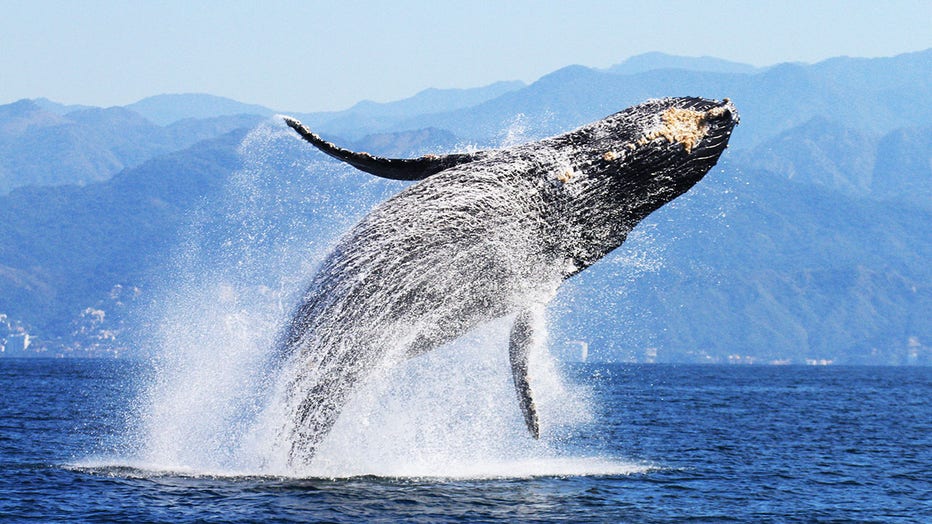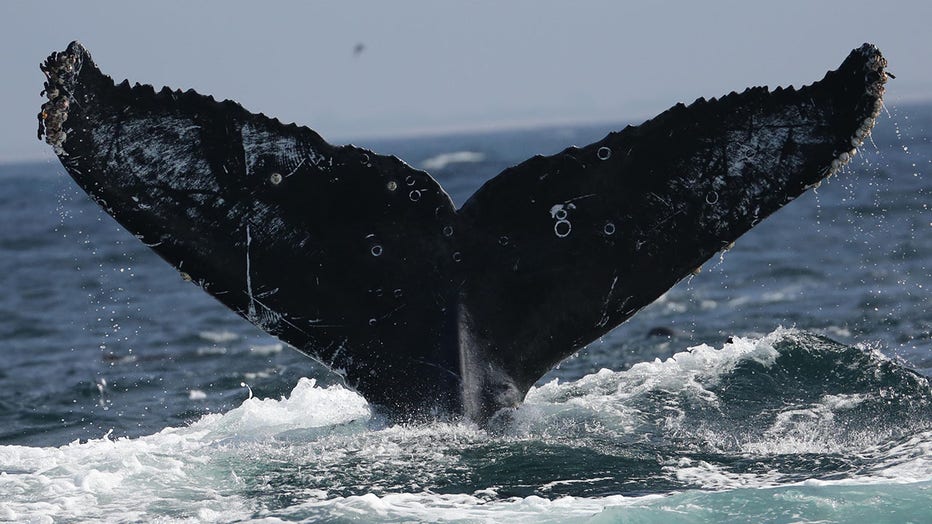‘Thousands of whales disappeared,’ likely starved to death amid strong heatwave: study
'Very rare' whale found dead, stranded near Mississippi Gulf Coast
(Credit: The Institute for Marine Mammal Studies Gulf Port Mississippi)
A new study shows that the number of humpback whales in the North Pacific Ocean fell by 20% between 2012 and 2021 amid a strong marine heatwave.
According to the study, published Feb. 28 in the journal Royal Society Open Science, researchers used artificial intelligence image recognition to identify individual whales from photos of their tails.
Lead researcher of the study, Ted Cheeseman, said the technique of matching the marine mammals by patterns and shapes of their tails dates back to the early 1970s, but at that time, it was extremely time-consuming.
"We changed that to be basically instantaneous and with that could gather all humpback whale photos that researchers and the public could give us," he told FOX Television Stations.

Breaching humpback whale in Nayarit, Mexico (Credit: Nicola Ransome/Ted Cheeseman)
Almost 800,000 photos were submitted to Happywhale – a whale identification website that Cheeseman founded. This allowed more than 100,000 individual whales around the world to be identified.
"[It] made us realize it was possible to track humpback whale populations year by year for the last 20 years, when before it had only ever been done with estimates every 10-20 years," Cheeseman explained.
The team found a decline of nearly 7,000 (6,826) whales between 2012 and 2021, which coincided with a massive marine heatwave between 2013 and 2017 sometimes referred to as "the blob."
"We didn’t believe it," Cheesman said of the results. "We worked for most of a year to test and confirm and improve our model estimates and statistics … We didn’t expect to see such a strong response in humpback populations. Imagine 20% of a state’s human population disappearing!"

A humpback whale known from the west coast of the United States and Mexico as Frosty - named after the snowman. (Credit: Ted Cheeseman)
The blob, a large mass of unusually warm waters in the Northeast Pacific, lasted from 2013 to 2017, according to Yale’s School of Environment. The warm waters of the blob were nutrient-poor and adversely affected marine life.
The researchers’ findings suggested that many of the whales likely starved to death because of the heatwave. While there are large uncertainties in the numbers, the team believes the decrease is real.
"We are confident that thousands of whales disappeared — most died from starvation — even though it is not at all what we wanted to see," Cheeseman added. "This was not intended to be a climate study, but since climate events are now quite often the biggest forces in the environment, this is what we found."
But, Cheeseman noted that it’s not all bad news.
RELATED: One of world’s smallest fish makes sound as loud as gunshot, scientists find
By the early 1970s, the United States had listed eight whales as endangered species. And in 1971, the U.S. officially outlawed whaling.
"50 years ago there were only an estimated 1200-1600 humpback whales in the North Pacific … the population is back to being generally healthy," Cheeseman said.
He added, "Oceans are resilient — recovery of great whales from whaling shows this — but they are also sensitive, and this marine heatwave today is an unusual event that if we don’t change, global emissions may soon become the norm. If that happens, the unusual event may be deadly to a lot more than 20% of the population of humpback whales."
Cheeseman said the team may extend their AI technology of image recognition to other species in the future to help better manage and understand oceans around the world.
This story was reported from Los Angeles.

